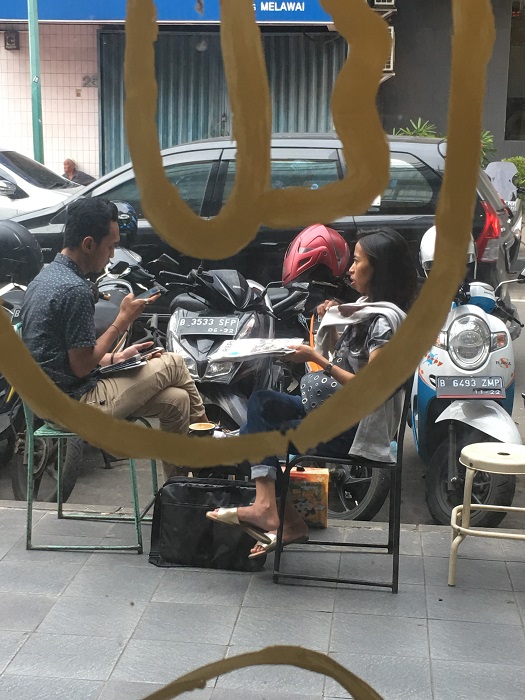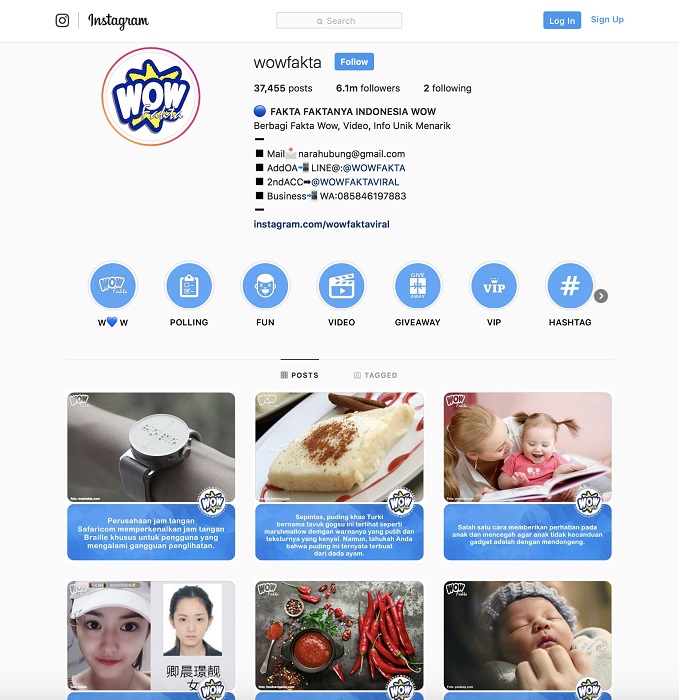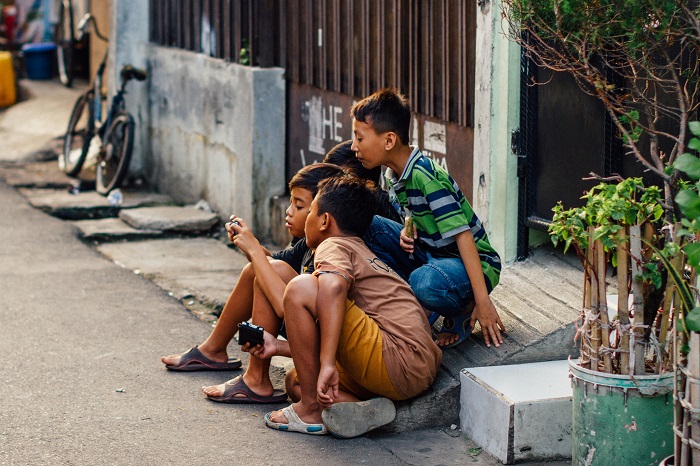Danau Tanu and Levriana Yustriani
‘Indonesia is facing a hoax emergency,’ said Maura when asked about the nation’s challenges. For Maura, an undergraduate student in Jakarta, the hoax emergency trumps terrorism. ‘I don’t think there’s any media that is trustworthy,’ said another student, Umi, in Makassar, Sulawesi. This intense distrust of the media is pervasive among current college students who make up the oldest of the digital native generation born in 1995 and after, who Jean M Twenge refers to as the ‘iGen’. And the main reason for their distrust? – the media’s blatant political bias. ‘Indonesian media is so polarised,’ Lukas complained.
In April of next year, Indonesians will go to the polls. Without any changes to the presidential candidates, Joko Widodo, the incumbent, will compete against Prabowo Subianto for a 2014 ‘re-run’ of sorts. The stakes of failing to grab the attention of young voters like Maura and her cohort – who seem obviously put off by the politicisation of the media – are high. Back in 2014, the number of voters between the ages of 17 and 25 accounted for approximately 30 per cent of the 190 million eligible voters in the country. Born in the age of digital technology, this generation’s political knowledge and attitudes are increasingly shaped by the online networks they often live in on a daily basis. Notwithstanding the internet and social media’s potential for increasing civic engagement, Indonesia’s young voters are drowning in information, online ads and political campaign messages.
Having all but abandoned the mainstream media, many of these youth are now relying heavily on personal networks for information – often viewed on social media and are not any more reliable. At the same time, they feel anxious about being ill-equipped to identify and filter out fake news.
Indonesia’s digital natives
The world of Indonesia’s university educated youth is characterised by digital media saturation. In 2017, the Indonesian Internet Service Providers Association (APJII) found that 49.5 per cent of internet users are aged 19 to 34, and the majority access the internet on their phones. The average Indonesian spends approximately three hours daily online on a smartphone. In 2014, there were more smartphone owners than bank accounts holders in Indonesia.
With ceaseless access to content at any hour of the day, the web and social media have become the perfect environment for hoaxes to blossom. According to a recent study from MIT, false stories can travel at least 10 times faster than factual stories. Given the intensity of competition among online media outlets, this environment encourages clickbait-style reportage, compromising journalism standards.
Meanwhile, the media landscape in Indonesia has become heavily politicised and commercialised in the post-reformasi era. The students we interviewed in Jakarta and Makassar are too young to remember former president Suharto’s 32-year rule that abruptly ended in 1998. Most only have vague knowledge of the political climate – including the lack of press freedom – that dominated their parents’ generation who grew up under the New Order (1966-98). But they could rattle off the names of the owners of TV stations at a second’s notice to point out – with disgust – that almost every major media outlet in Indonesia is controlled by businessmen-turned-politicians: TVOne by Aburizal Bakrie; MetroTV by Surya Paloh; and RCTI, MNC TV, Global TV and iNews by Hary Tanoesoedibjo.

While the clickbait strategy may increase viewership temporarily and the media moguls may benefit by using their broadcast and online networks to further their political ambitions, these strategies risk destroying the public’s trust in the media. College students have expressed especially strong opinions against traditional news outlets, preferring to walk away from them in favour of sourcing information from social media and their personal networks.
The politicisation of the media
‘I don’t watch TV, to be honest, especially not the news because it is so not neutral,’ Maura complained in disgust. Likewise, Dina pointed out that RCTI ‘insists on reporting about Hary Tanoe,’ RCTI’s majority shareholder and 2014 vice-presidential candidate whose political ambitions have yet to wane. ‘Sometimes when I watch [RCTI] by accident,’ Dina said, careful to note that she does not go out of her way to watch the station, ‘I feel they turn mundane things into news. So I don’t feel like watching. Like, he’ll be giving out charity stuff or visiting people in the market.’
But it wasn’t just the news that was biased – even the entertainment programs are politicised. ‘Once there was this sinetron (soap opera) on RCTI, right?’ explains Dina, ‘And Wiranto would often, like, have a cameo appearance to promote himself.’ Wiranto is another former presidential candidate and Tanoe’s running mate in 2014. ‘Thanks to the MNC group, I now rarely watch its news channel, iNews. If I do, I only watch sports. MetroTV and TVOne is like that too.’
According to the students, the media owners’ display of their political interests and agendas are too vulgar to ignore. Many young people consider mainstream media a source of hoaxes and this distrust has led some to turn to other sources of information – some of those being even less reliable.
Hoaxes, facts and algorithms
‘Hoaxes are now rampant,’ complained Ina, a Communications major in Makassar. In 2016, the Ministry of Communication and Information Technology found 800,000 websites that were responsible for spreading fake news and hate speech. In spite of the aggressive efforts by the government to take down the websites, they persist. Hundreds of new websites emerge daily using different names because they can profit big from digital ads without the need for capital to hire editors, journalists, and so on. In a year, a fake-news website can generate hundreds of millions of rupiah (tens of thousands of Australian dollars) by attracting millions of users to the page. In a country with 130 million active social media users, Indonesians cannot escape from the daily online exposure to misinformation.
At times, however, their distrust of the politicised media landscape causes young people to conflate poor journalism with deliberately-produced-for-profit hoaxes. Ina claims that she once saw one of the largest broadcasting networks air a news segment that in her view was ‘obviously a hoax.’ The network, Ina says, accused the 212 demonstrations of being ‘anarchic’. These were the ‘anti-Ahok’ marches of 2 December 2017 where an estimated half-a-million people marched in Jakarta demanding that the then-governor Ahok, an ethnic Chinese Christian, be investigated for blasphemy. Ina says the network reported that people were ‘stepping on grass and throwing rubbish.’ She, on the other hand, said there had been a video on instagram clearly showing that ‘nothing had happened.’ She also recalled that there were many more media outlets reporting through social media that ‘there was no issue.’ Ina concluded that the network in question was ‘a den of hoaxes.’
In verifying information, some students seemed to conflate popularity with accuracy. Ina emphasised that while that network had only shown one photograph of chaos, there were many photographs showing that such chaos did not occur. Others relied on the popularity of the information within their personal networks as an indication of accuracy, such as asking friends whether they had read the same news. Others, like Rizal, may check reports by one media outlet against other outlets or, in the case of op-eds, against one of Indonesia’s largest discussion forums, Kaskus, to see whether others have expressed the same opinion.
Relying on social media
For their news diet, many college students say they rely on Line Today (curated news in a chat application) or Instagram’s Explorer function. Both of these are driven by algorithms that show ‘news’ that is either currently most popular, most similar to stories that the user has clicked on before, or has been posted by accounts followed by the user. Hence, they can act as echo chambers by pushing news that reflects the user’s own views back to them. But rarely did the students appear to be aware of this effect.
Those who rely on Line Today and Instagram Explorer, unsurprisingly, tended not to focus on the importance of the credibility of an information source. Rizal offered, ‘I open Instagram a lot, and I follow all these accounts about facts, right? And if it’s about history, then I’ll try to cross check it on Google … If on average Google says A, then I’ll conclude that it’s true’. Rizal also confidently proclaimed, ‘Seventy per cent of the accounts I follow are about facts, science, or history’. He was implying that the accounts he followed offered more substantial knowledge than the accounts his peers followed.
However, the Instagram accounts Rizal followed offered little more than trivial information. For example, @wowfakta merely curates images accompanied by short texts extracted from news websites, including many with low journalistic standards. The account makes no attempts to verify the credibility of the information nor the original source. The account curators are also anonymous, leaving followers with no means of assessing their credibility. Even so, @wowfakta has amassed over 6 million followers by reproducing online content in convenient bite-size format that social media users can easily digest in a split second.

Credibility of sources
Some students, of course, made clear distinctions between hoaxes and news, and often differentiated further between non-hoax news sources that they deemed credible, and those they did not. Maura, for example, relies on mainstream media to stay up to date, but when it comes to analysis of the issues, she turns to either Tirto.id, known for its in-depth reports, or Kumparan, a ‘collaborative news media platform’. Despite being new players in Indonesia’s media sector, both Tirto and Kumparan quickly gained popularity among online news readers for their non-partisan news coverage – a stark contrast with the major media outlets. Maura believes that ‘good analysis’ is characterised by the absence of ‘sentimen’, or emotional bias, and the ability to ‘really breakdown the issue’ from various perspectives.
Ali, an economics major in Makassar, explained that he would sometimes check facts presented by broadcast news channels by going directly to the source, such as the website of the government agency or other organisation in question. Ali had clear, specific ideas on how to assess the credibility of information.
All news is fake news?
In spite of their being tech-savvy and confident sourcing information online, some young people seem to have difficulty assessing credibility, too often being swayed by the algorithm-driven perceived popularity of a news item, and the opinions of individuals in their own social circles.
While most students were keenly aware of the political bias of news outlets, many were simply incredibly skeptical of all media. When asked if there was still any media she found credible, Rima responded, ‘I don’t even really trust the media on my campus. And even [scientific] journals – I don’t quite trust them’. Worryingly, studies have shown that those who strongly distrust the media are less able to differentiate between real and fake news.

In contrast, those like Maura and Asman, who are confident in their own ability to assess the credibility of information sources, are more inclined to trust some selected media outlets rather than distrusting all of them. Even so, Maura confided that she is against regulating the media for fear of a return to the strong-handed control of press freedom seen during the New Order era. ‘If the government started meddling in the media,’ Maura said, ‘it would instead backfire against the government because people will think they are obstructing democracy’
The erosion of trust in mainstream news media combined with young people’s difficulty in verifying the source of other media is concerning. When the New Order regime fell in 1998, Indonesia embraced media freedom with gusto for its role in providing a check on authority in the new democracy. But young people’s turning away from news media deprives them of the opportunity to develop critical perspectives and contribute to creating a robust public debate – though it is not just young people’s fault. In the absence of rigorous education in critical analysis, the flagrant politicisation of the media for financial and political gain has much to answer for.
Danau Tanu (@danautanu) is an honorary research fellow in the School of Social Sciences at the University of Western Australia, and the author of Growing Up in Transit: The Politics of Belonging at an International School.
Levriana Yustriani (levriana.yustriani@gmail.com) is a researcher based in Jakarta with an interest in new media, youth and politics. She is also an Australia Awards recipient with a Masters in Global Media Communications from the University of Melbourne.
![/ Larry McCallum [Flickr Creative Commons]](/images/Edition131Weeklies/quarterly/Larry-McCallum-Flicker-sm.jpg)